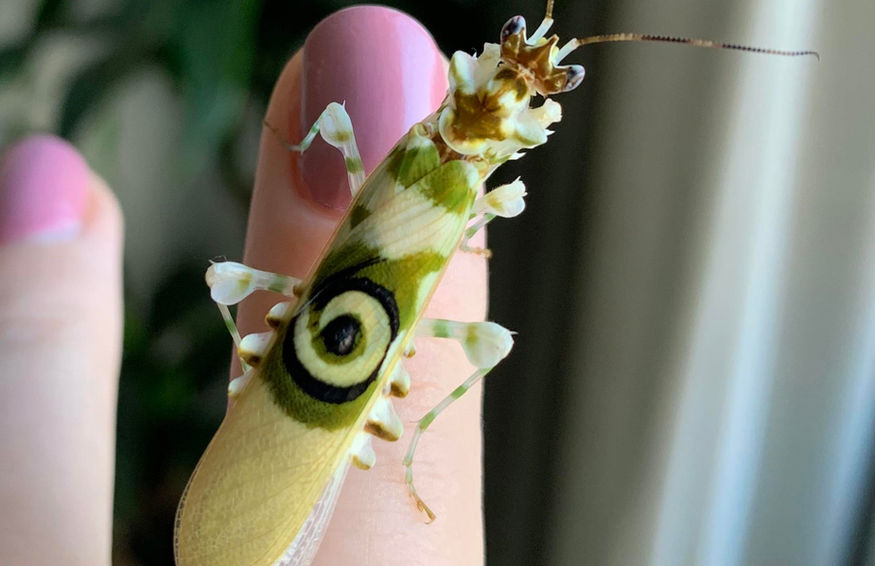Pseudocreobotra wahlbergII
(Spiny Flower Mantis)

Size
Males: 2 – 2.5 inches / 6 – 7 cm
Females: 2 – 2.5 inches / 6 – 7 cm
Distribution
Sub-Saharan Africa, Tropical and Subtropical Grasslands
Difficulty
Intermediate
Humidity
60 – 70%, with good ventilation
Temperature
75 – 85F / 25 - 30C
Total Lifespan - (From Hatchling through Adulthood)
Males: 4 – 5 months
Females: 7 – 10 months
Color Variations
White, pink, red, green, with green color stripes in most color morphs
Introduction
P. wahlbergii is a beauty of the mantis world. This African mantis is found in tropical and subtropical savannah, and is an amazing flower mantis species. Not only are they covered by many stripes, spines, and patterns, they are able to change their colors to match flowers, and can be found in the wild as white, yellow, pink, or even green. These enigmatic chameleons also have an excellent defense for when they are found. They will spread out their arms and spread their wings, revealing their bright yellow hindwings and eyespot on their forewings.
This species is an intermediate level mantis in part due to its aggressive feeding nature & need for ventilation. This species will readily tackle flying prey as big or bigger than they are thanks to its stout, powerful body. If threatened, this mantis will not shy away. Instead, it stands its ground and quickly strikes and displays at the threat. Its short-tempered personality makes it one of the most popular mantises in the hobby to date!
Sexing
As with all mantises, males have 8 external sternites, and females have 6. Males have an extra middle spine on the bottom of their abdomen (6 spines in the middle row vs the female’s 5).
Keeping
Pseudocreobotra can be kept communally until 3rd instar after which it is advisable to separate. They become more territorial at this stage to smaller individuals so ample space should be provided. Offering multiple perches via sticks or plants is recommended for communal setups to help avoid conflict. This species can climb plastic well when young, but has some difficulty at adulthood.
As a savannah species, good ventilation and frequent misting are both a must. Provide airflow by using an enclosure with multiple screen windows, as just one at the top may not be sufficient. Not only are spinies thirsty, but they can be prone to fungal infections if ventilation is very poor.
Recommended minimum space is as follows:
Instar 1 – 3: 8 oz Deli Cup
Instar 4 - Adult: 32 oz / 1 liter Deli Cup
Feeding
Instar 1 - 3: Fruit Flies
Instar 4 – Adult: House Flies, Bluebottle Flies, Moths, Small Crickets, Roaches
Breeding
Males mature at 2 weeks into adulthood, and females take between 4 – 6 weeks. It is recommended to have multiple males on hand per female.
This species can be difficult to pair due to the female’s aggressiveness. A female spiny can eat a surprisingly large amount of food, and is also quickly bothered and prone to threat displaying at the male.
This irritability makes mating a challenge for this species. However, there are ways to circumvent this.
Start by placing the female on a surface and offer her an item of food. Once she takes it, slowly bring the male behind the female and ease him onto her back. If done properly, the male will lower his antennae and climb on fully. The food will distract the female and the male should be able to mate easily. Leave the pair with additional bluebottle flies in the cage in case the female becomes hungry again.
Mating will last anywhere from 6 – 10 hours. Afterward, the female will lay an ootheca every 2 – 3 weeks. Each ootheca will contain anywhere from 30 – 60 nymphs depending on size. After 4 – 6 weeks of incubation at room temperature and 60 – 70% humidity, an ootheca will hatch all the nymphs at once. They can be fed melanogaster fruit flies after 24 hours.


















